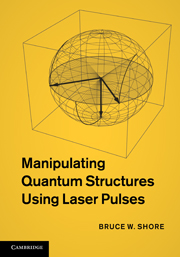Book contents
- Frontmatter
- Contents
- Preface
- Acknowledgments
- 1 Introduction
- 2 Atoms as structured particles
- 3 Radiation
- 4 The laser–atom interaction
- 5 Picturing quantum structure and changes
- 6 Incoherence: Rate equations
- 7 Coherence: The Schrödinger equation
- 8 Two-state coherent excitation
- 9 Weak pulse: Perturbation theory
- 10 The vector model
- 11 Sequential pulses
- 12 Degeneracy
- 13 Three states
- 14 Raman processes
- 15 Multilevel excitation
- 16 Averages and the statistical matrix (density matrix)
- 17 Systems with parts
- 18 Preparing superpositions
- 19 Measuring superpositions
- 20 Overall phase; interferometry and cyclic dynamics
- 21 Atoms affecting fields
- 22 Atoms in cavities
- 23 Control and optimization
- Appendix A Angular momentum
- Appendix B The multipole interaction
- Appendix C Classical radiation
- Appendix D Quantized radiation
- Appendix E Adiabatic states
- Appendix F Dark states; the Morris–Shore transformation
- Appendix G Near-periodic excitation; Floquet theory
- Appendix H Transitions; spectroscopic parameters
- References
- Index
22 - Atoms in cavities
Published online by Cambridge University Press: 07 October 2011
- Frontmatter
- Contents
- Preface
- Acknowledgments
- 1 Introduction
- 2 Atoms as structured particles
- 3 Radiation
- 4 The laser–atom interaction
- 5 Picturing quantum structure and changes
- 6 Incoherence: Rate equations
- 7 Coherence: The Schrödinger equation
- 8 Two-state coherent excitation
- 9 Weak pulse: Perturbation theory
- 10 The vector model
- 11 Sequential pulses
- 12 Degeneracy
- 13 Three states
- 14 Raman processes
- 15 Multilevel excitation
- 16 Averages and the statistical matrix (density matrix)
- 17 Systems with parts
- 18 Preparing superpositions
- 19 Measuring superpositions
- 20 Overall phase; interferometry and cyclic dynamics
- 21 Atoms affecting fields
- 22 Atoms in cavities
- 23 Control and optimization
- Appendix A Angular momentum
- Appendix B The multipole interaction
- Appendix C Classical radiation
- Appendix D Quantized radiation
- Appendix E Adiabatic states
- Appendix F Dark states; the Morris–Shore transformation
- Appendix G Near-periodic excitation; Floquet theory
- Appendix H Transitions; spectroscopic parameters
- References
- Index
Summary
The fields within cavities differ in an important respect from those of a laser beam in free space: The bounding surfaces that define the cavity enclosure impose constraints that limit the fields to discrete modes, characterized in part by discrete frequencies. The surfaces enclosing a cavity are boundaries where the dielectric properties change abruptly; they are idealized as discontinuities of the susceptibility ∊ and permeability μ. Across any such surface the normal component of the B field is continuous, as is the transverse component of the E field. These conditions imply, for example, that along a perfectly conducting surface (an idealized mirror) the electric field has a node. The allowed fields (the discrete mode fields) are then particular solutions to the Maxwell equations, or their conversion into Helmholtz equations, that vanish along bounding surfaces.
Figure 4.2 of Sec. 4.1.3 depicts two classes of cavities. Frame (a) shows a cylindrical cavity used for microwave radiation. The cavity completely encloses the field, apart from a small aperture through which the atoms pass. Frame (b) shows a prototype optical cavity, in which the cavity field is that of a beam confined along one axis. Idealized as perfect conductors, the confining mirrors permit only integral half waves between them, and the frequencies of such plane waves are correspondingly discrete. Because the enclosing endmirrors are not perfectly reflecting there will occur some loss through them, along the cavity axis, and the field is not strictly monochromatic.
- Type
- Chapter
- Information
- Manipulating Quantum Structures Using Laser Pulses , pp. 419 - 434Publisher: Cambridge University PressPrint publication year: 2011

